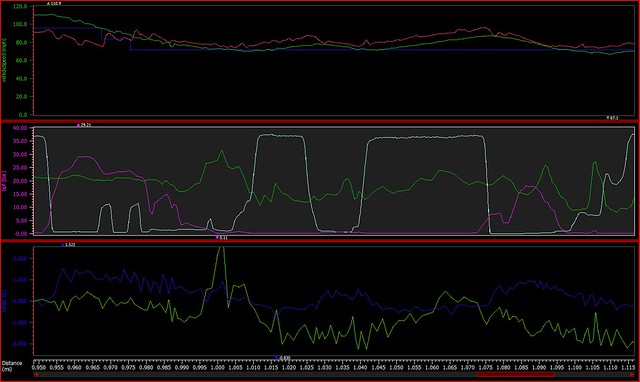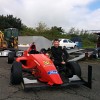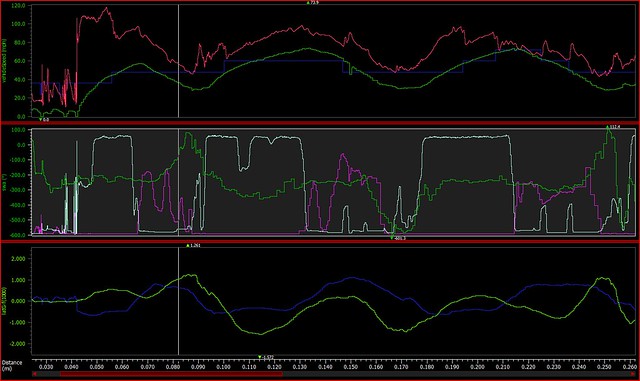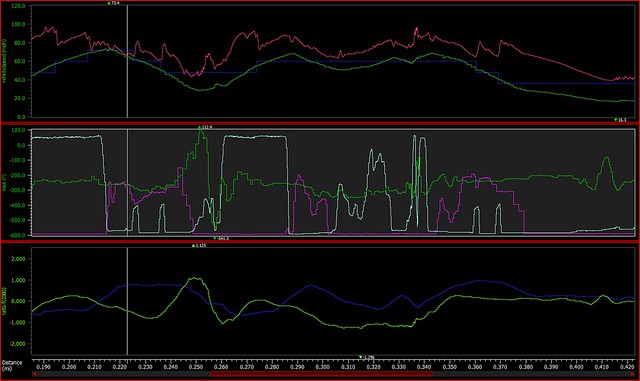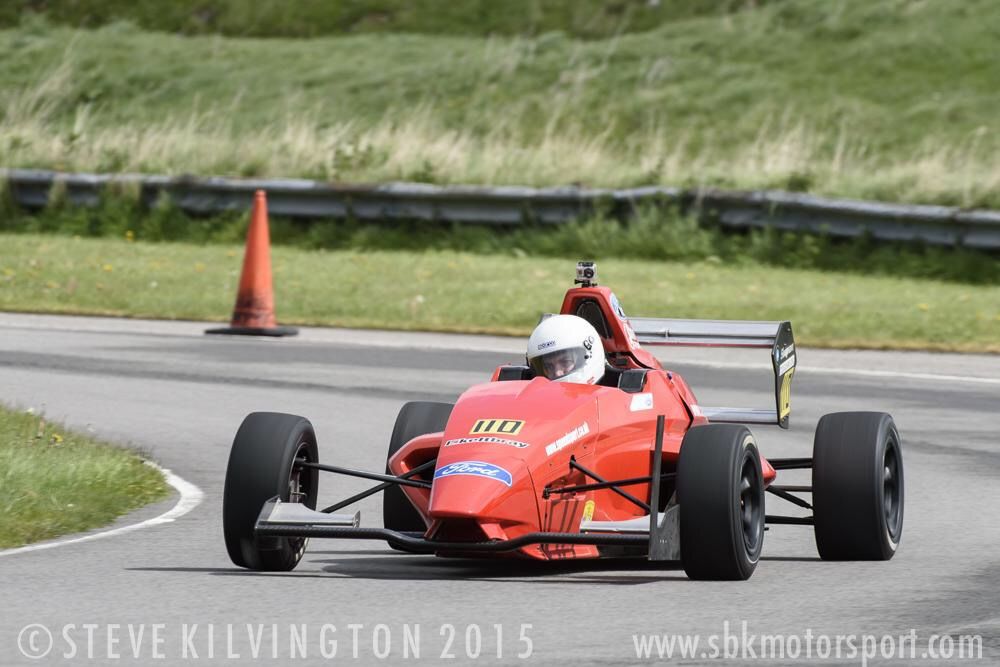
The Mygale saw its first outing at the Bristol Llandow Sprint. I'd not warmed the engine up before the event started, so this was a baptism of fire. First practice was wet after a shower whilst I was waiting to go out on my new slicks and a lurid slide out of Glue Pot grabbed my attention. Second practice was dry and here's what it looked like. My fastest run was a PB for me and thanks to the Life ECU, I have some pretty good data to show how it progressed...
The data is presented in three graphs (click for full size). The top graph shows engine speed (RPM) in red, selected gear in blue and speed (mph) in green. It should be noted that the speed trace is calibrated for a different size of tyre and reads a few percent below what it should. The middle graph shows steering angle in green, throttle position in light blue and brake pedal pressure in purple. The bottom graph simply shows lateral G in green and longitudinal G in blue.
This run is the fastest of the day. The white vertical marker on all three graphs shows the start of the run. After the launch, full throttle is never found and at about 0.18 miles, the steering trace drops, which indicates turning right into the first corner, whilst also selecting 2nd gear. At about 35mph, this is quite early, but the car still has enough revs that lag isn't huge. Given how gently the wheel was turned and that lateral G barely exceeds 1, this suggests that a later turn-in at higher speed was possible. Full throttle was achieved after the apex and lifting the throttle whilst turning in was enough to scrub speed off for the corner. The dip in the RPM graph at this point shows that the rear wheels under-rotated, which probably helped turn-in. Lateral was ~1.5G, which seems about right for cold tyres.
Full throttle was again used on the run into the next right-hander. Two bites of the wheel were taken into the right-hander, the first with a partial lift and the second with a brush of the brakes. This is my reaction to the shape of the decreasing radius corner; you can see the radius being determined by my use of brake pedal pressure rather than steering angle. Lateral G doesn't vary much during this.
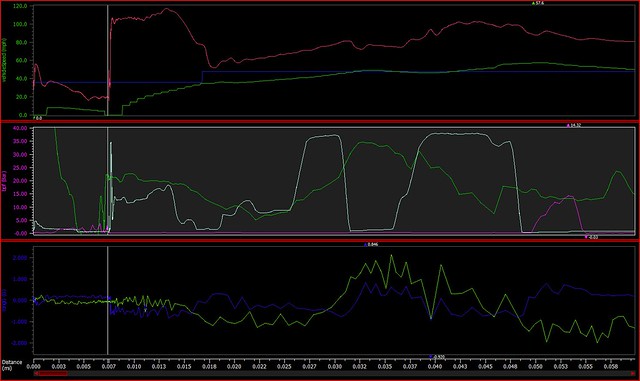
The data is presented in three graphs. The top graph shows engine speed (RPM) in red, selected gear in blue and speed (mph) in green. The middle graph shows steering angle in green, throttle position in light blue and brake pedal pressure in purple. The bottom graph simply shows lateral G in green and longitudinal G in blue.
This run is the fastest of the day. The white vertical marker on all three graphs shows the start of the run. After the launch, full throttle is never found and at about 0.18 miles, the steering trace drops, which indicates turning right into the first corner, whilst also selecting 2nd gear. At about 35mph, this is quite early, but the car still has enough revs that lag isn't huge. Given how gently the wheel was turned and that lateral G barely exceeds 1, this suggests that a later turn-in at higher speed was possible. Full throttle was achieved after the apex and lifting the throttle whilst turning in was enough to scrub speed off for the corner. The dip in the RPM graph at this point shows that the rear wheels under-rotated, which probably helped turn-in. Lateral was ~1.5G, which seems about right for cold tyres.
Full throttle was again used on the run into the next right-hander. Two bites of the wheel were taken into the right-hander, the first with a partial lift and the second with a brush of the brakes. This is my reaction to the shape of the decreasing radius corner; you can see the radius being determined by my use of brake pedal pressure rather than steering angle. Lateral G doesn't vary much during this.
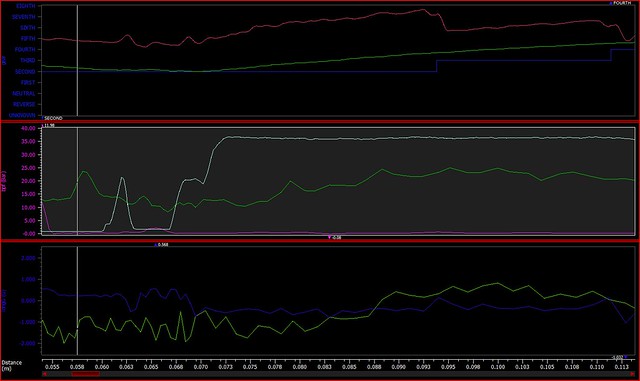
Arriving at the fast right-hander onto the back straight, turn-in is on full throttle in fourth gear. The vertical marker shows the point the throttle is released and also shows the left foot dragging on the brake pedal whilst the right foot picks up the throttle realisign this is too much of a lift. The steering trace shows that some opposite lock was applied when the throttle was closed as a result of under-rotation of the rear wheels shown by the red RPM trace dipping. The throttle is then increased from 15% to 65% and this results in a second steering correction, which must have neutralised any wheelspin. Lateral acceleration reaches around 1.8G, which suggests moderate downforce at these speeds.
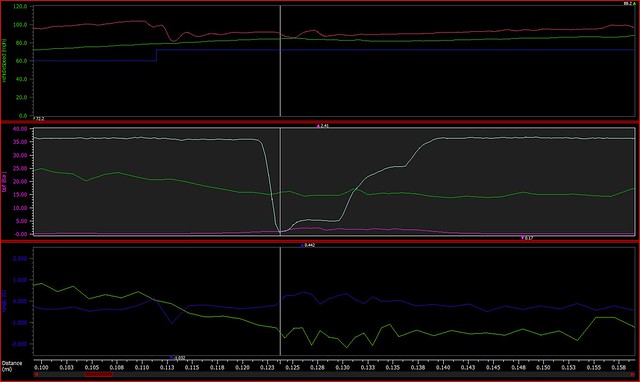
Arriving at the chicane at the end of the back straight, I'm in 6th gear and apply the brakes properly for the first time, retarding the car at around 1.5G. Pedal pressure is not reached immediately, so I need to work on hitting the brakes more quickly. It is immediately clear that I've braked too early and bleed off pedal pressure quickly. I drop two gears, although clearly go to drop three but have not released the lever enough to engage the ratchet for the final downshift.
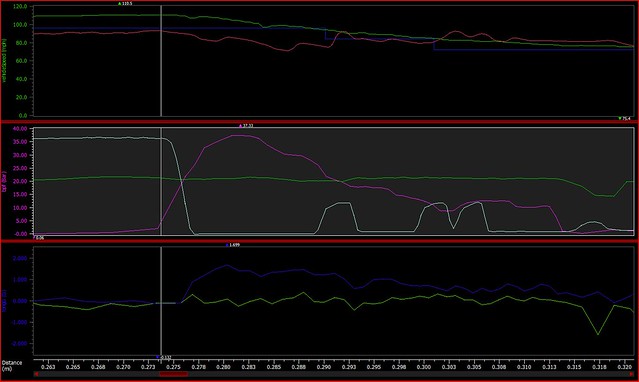
Picking the story up at the verticl marker, I bleed off the last of the pedal pressure and turn in whilst simultaneously applying throttle. Answers on a postcard why! The curious pedal movements continue as the wheel turns left for the second apex and both throttle and a little brake are applied. Naturally, this affects lateral G and the rear tyres scrabble for grip. Turning into the right hander, feet have once again resumed normal behaviour and neith pedal is in use. Application of the throttle co-incides with a little corrective lock and a spurious peak lateral acceleration of 2.8G! In real terms, it's about 1.7G, which is in line with the speed of 70mph and the increased tyre temperature (and grip) from the last corner.
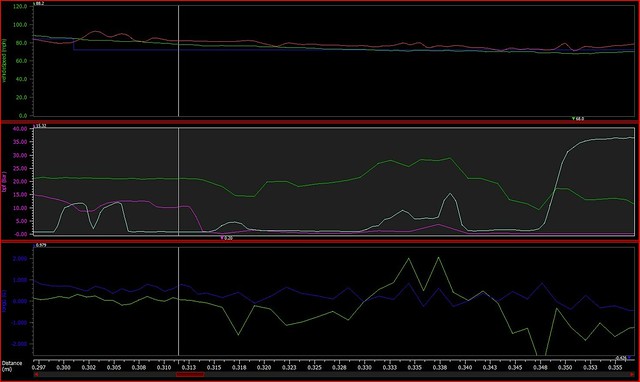
Cornering at ~1.2G, I decided mid-corner that I'd applied the throttle too early and lifted completely. The dip in the RPM trace again shows under-rotation of the rear wheels followed by the throttle being picked up and opposite lock being applied. The corner radious clearly decreased as a result because lateral G went up significantly to around 1.7G and speed did not vary. Full throttle was applied and steering lock taken off at the corner opened up.
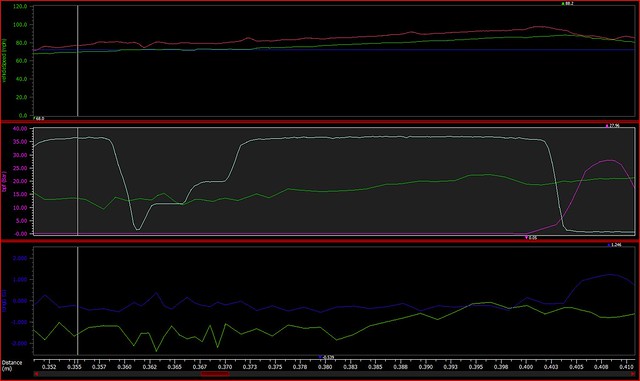
The final corner onto the front straight is approached at around 90mph whilst still turning right. As a result, brake pressure was lower than previously and retardation peaked at 1.2G whilst still cornering at 0.7G. I'm not sure why I released the brake pedal during braking. Perhaps because I realised I'd braked too early.
Turn-in occured with the re-application of brake pedal pressure. Whilst still feeding in lock, I was also applying some throttle, which suggests I thought I was travelling too slowly and needed to pick up pace. Lateral acceleration at under 1.5G amplifies this theory and the RPM trace shows a spot of wheelspin as the throttle is applied. The throttle was once again picked up and soon flat out as the corner opens up onto the straight.
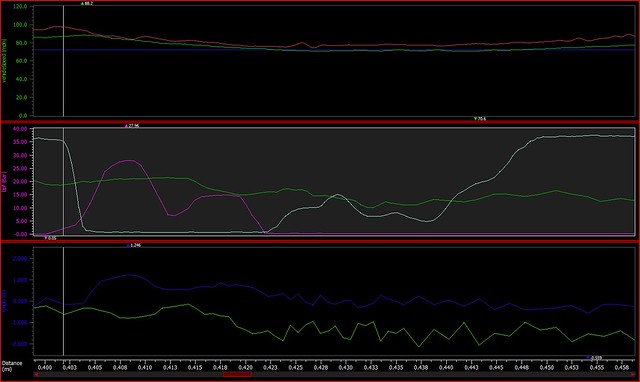
At the end of the front straight, I approached the bus stop for the first time in 6th gear, hitting the brakes quickly and consistently to slow the car at 1.5G. I released the brakes during the downshifts from 6th to 4th and further still for the downshifts to 2nd. Deceleration was not as rapid as a result, despite the engine braking.
I turned in sharply whilst releasing brake pressure and this clearly caused oversteer as the wheel is straightened. Two pules of throttle split by a brush of the brake pedal match the further application of steering angle, suggesting an attempt to balance the car. It's a similar story in the right-hander that follows before full throttle on the exit, which seems to be about on the limit for the tyres as the RPM trace wobbles a little. Given the low revs in use here, this validates the use of 2nd gear through this section.
The left apex required a half second lift of the throttle and the application of throttle coincides with some lock coming off, suggesting that the car is sliding nicely at full throttle.
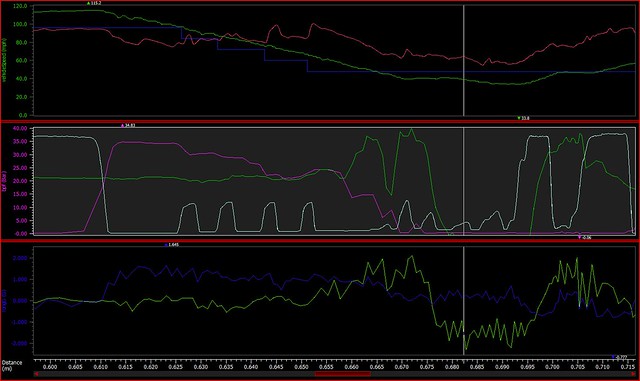
I arrived at the right-hander in second gear. I fed in steering angle and brake pedal pressure at the same time to match the decreasing radius of the corner. The dip in the RPM trace shows the rear wheels were under-rotating on turn-in. Immediately after releasing the brakes, I was on the throttle whilst still winding on lock. This was clearly too early as a partial lift was needed before full throttle was applied whilst still cornering at over 1.5G.
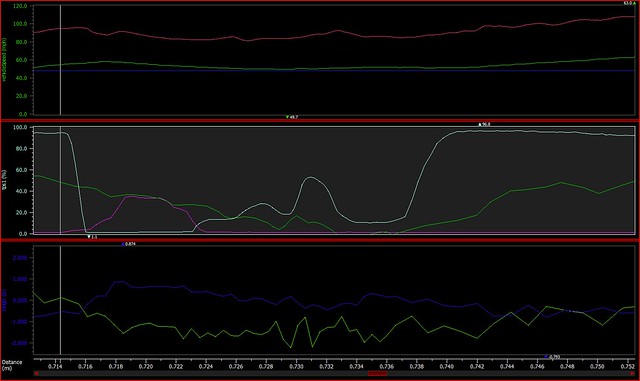
Arriving at the final corner before the back straight, I'd already shifted up two gears into fourth gear and shortly after turning in, a partial lift was deemed necessary. Nearly full throttle was applied and the RPM trace shows that the rear wheels were not spinning, thus the rear end is not grip limited. Is this a rearward aero balance or was I not on the limit? Lateral G was down at 1.5G, which is low considering the temperature in the tyres on lap 2 and the high speed at this point.
A further lift of the throttle aligned with more steering angle unsettled the rear but this quickly stabilised and throttle was soon applied to exit the corner where lateral G rose to around 1.8G, peaking at well over 2G. It looks like I need more confidence here.
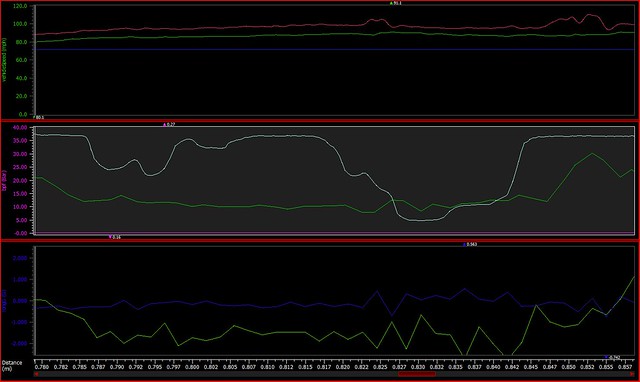
I arrived at the end of the back straight in sixth gear and applied pedal pressure to retard the car at about 1.4G. This is lower than the lateral acceleration being achieved, so I either need to brake harder or the camber angles on the car are severely compromising the braking performance. Pedal pressure was bled off for the two downshifts and further still as the car was eased into the first apex. The brakes were released for the second apex and I clipped the kerb, causing my foot to touch the throttle and a big spike in lateral G from the attitude of the car. Full throttle was applied almost immediately and steering angle applied for the right-hander.
Mid-corner, I lifted off the throttle and lightly brushed the brakes (just resting my foot on the pedal), which led to under-rotation of the rear wheels shown on the RPM trace and caused some oversteer as shown by the steering trace. Full throttle was again applied with a little wheelspin being the result, even when the steering was nearly straight. Braking into the final corner happened at a similar time to turn-in and oversteer was the result with two pronounced steering corrections. Application of the throttle then caused the rear to slide and a large correction was again required before full throttle was attained all the way to the finish line.
